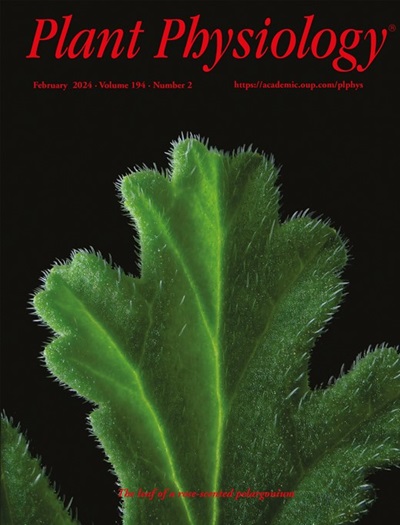Nitric oxide cross-links calcium signals to enhance cold tolerance via inhibiting calmodulin expression in watermelon
IF 6.5
1区 生物学
Q1 PLANT SCIENCES
引用次数: 0
Abstract
Nitric oxide (NO) is a pivotal gaseous signaling molecule that plays a critical role in regulating plant tolerance to cold stress; however, the underlying mechanisms of signal transduction remain poorly elucidated. In this study, knockout of nitrate reductase 1 (ClNR1), a crucial gene for NO biosynthesis, led to reduced cold tolerance in watermelon (Citrullus lanatus), accompanied by downregulation of cycle nucleotide-gated channel (ClCNGC) 20, a key Ca2+-permeable channel gene, decreased Ca2+ influx, and upregulation of calmodulin (ClCaM) 2/5/7. Conversely, application of the NO donor SNP exhibited contrasting effects compared to NR1 knockout. Silencing ClCNGC20 counteracted SNP-induced Ca2+ influx, downregulation of ClCaM 2/5/7, and cold tolerance. Silencing ClCaM2/5/7 alleviated the inhibition on C-REPEAT BINDING FACTOR (ClCBF) expression and cold tolerance induced by ClNR1 knockout or ClCNGC20 silencing. Multiple experimental approaches revealed the interactions between ClCaM2/5/7 and voltage-dependent anion channel (ClVDAC) 1 proteins. Overexpression of ClVDAC1 hindered the induction of ClCBF expression and cold tolerance triggered by SNP or CaCl2, whereas ClVDAC1 silencing mitigated the inhibition on ClCBF expression and cold tolerance caused by ClNR1 knockout or ClCNGC20 silencing. Additionally, cold stress rapidly triggered Ca2+ influx, which stimulated NO production. These findings suggest that Ca2+ influx promotes NO generation, which leads to further Ca2+ influx via upregulating ClCNGC20, forming a positive feedback loop that enhances cold tolerance. Furthermore, ClCaM2/5/7 interacts with ClVDAC1 to negatively regulate the NO- and Ca2+ signaling-mediated CBF pathway and subsequent cold tolerance.一氧化氮交联钙信号,通过抑制钙调素表达增强西瓜的耐寒性
一氧化氮(NO)是一种重要的气体信号分子,在调节植物对冷胁迫的耐受性中起关键作用;然而,信号转导的潜在机制仍然不清楚。在这项研究中,敲除硝酸盐还原酶1 (ClNR1)是NO生物合成的关键基因,导致西瓜(Citrullus lanatus)的耐寒性降低,并伴随着周期核苷酸门控通道(ClCNGC) 20(一个关键的Ca2+渗透通道基因)的下调,Ca2+内流减少,钙调蛋白(ClCaM)上调2/5/7。相反,与NR1敲除相比,NO供体SNP的应用表现出截然不同的效果。沉默ClCNGC20可抵消snp诱导的Ca2+内流、clcam2/5/7的下调和耐寒性。沉默ClCaM2/5/7可减轻ClNR1敲除或ClCNGC20沉默诱导的C-REPEAT BINDING FACTOR (ClCBF)表达和耐寒性的抑制。多种实验方法揭示了ClCaM2/5/7与电压依赖性阴离子通道(ClVDAC) 1蛋白之间的相互作用。ClVDAC1的过表达阻碍了SNP或CaCl2对ClCBF表达和耐寒性的诱导,而ClVDAC1的沉默则减轻了ClNR1敲除或ClCNGC20沉默对ClCBF表达和耐寒性的抑制。此外,冷胁迫迅速触发Ca2+内流,刺激NO的产生。这些发现表明,Ca2+内流促进NO的产生,而NO的产生通过上调ClCNGC20导致进一步的Ca2+内流,形成一个增强耐寒性的正反馈循环。此外,ClCaM2/5/7与ClVDAC1相互作用,负向调节NO-和Ca2+信号介导的CBF途径和随后的冷耐受性。
本文章由计算机程序翻译,如有差异,请以英文原文为准。
求助全文
约1分钟内获得全文
求助全文
来源期刊

Plant Physiology
生物-植物科学
CiteScore
12.20
自引率
5.40%
发文量
535
审稿时长
2.3 months
期刊介绍:
Plant Physiology® is a distinguished and highly respected journal with a rich history dating back to its establishment in 1926. It stands as a leading international publication in the field of plant biology, covering a comprehensive range of topics from the molecular and structural aspects of plant life to systems biology and ecophysiology. Recognized as the most highly cited journal in plant sciences, Plant Physiology® is a testament to its commitment to excellence and the dissemination of groundbreaking research.
As the official publication of the American Society of Plant Biologists, Plant Physiology® upholds rigorous peer-review standards, ensuring that the scientific community receives the highest quality research. The journal releases 12 issues annually, providing a steady stream of new findings and insights to its readership.
 求助内容:
求助内容: 应助结果提醒方式:
应助结果提醒方式:


